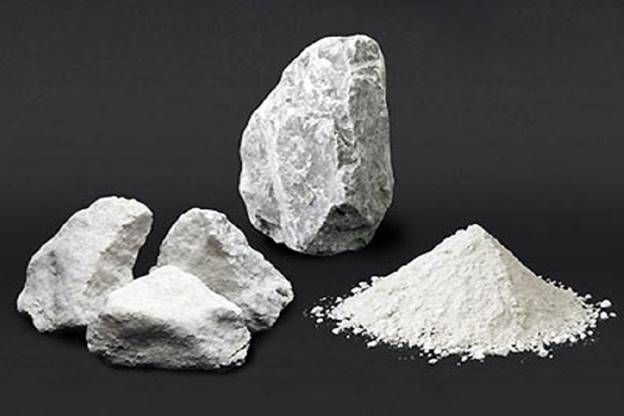In response to the question of what calcium carbonate is, it should be said that calcium carbonate is an inorganic compound with the molecular formula CaCO3. This mineral composition is commonly known as limestone, marble, and calcite. Calcium carbonate is a neutral inorganic compound that is significantly insoluble in water and soluble in hydrochloric acid. Various types of calcium carbonate are produced and used in industry. Including:
- heavy calcium carbonate
- light calcium carbonate
- Nano Calcium Carbonate (Micro Calcium Carbonate)
Calcium carbonate is mainly used as a caking agent, which can reduce the manufacturing cost of products. The rubber, plastic, polymer, concrete and cement industries are among the most important industries that use calcium carbonate. Although calcium carbonate and talcum powder look similar, there are many differences between them.

What is talcum powder?
Talc is a magnesium silicate mineral with the structural formula (Mg6)[Si8]It is O20 (OH) 4. The exact composition of talc depends on where it was extracted. Those extracted from different places may have different proportions of MgO, SiO2 and H2O. Talc has a layered structure consisting of a layer of magnesium hydroxide sandwiched between two layers of silica.
These three layers are held together by weak van der Waals chemical bonds. Therefore, they slide through each other with relative ease when subjected to shearing. This metal has the characteristics of hardness and high melting point. Talcum powder is a good insulator for electricity and heat. Other features of talcum powder include:
- Low expansion and contraction strength
- High dispersion
- High oil absorption rate
- High water permeability
- High price slippage
- Small coefficient of friction
- Stable chemical properties
- Acid and alkali corrosion resistance
Due to its stable chemical properties, talcum powder is widely used in paper, chemical, paint, ceramics, cable, rubber and other industries. The use of calcium carbonate and talcum powder has many advantages for various industries. Including reducing the cost of products and increasing the quality.
Differences and similarities between calcium carbonate and talcum powder
In this section, we will compare and describe the differences and similarities between calcium carbonate and talcum powder.
Both talcum powder and calcium carbonate powder are mainly used as fillers. The properties of talcum powder are as follows:
- Cut costs
- Reduce product shrinkage rate
- increase in size
- Increase product hardness
One of the main differences between calcium carbonate powder and talcum powder is the difference in their appearance. Talc is in the form of flakes, so it has higher strength, dimensional stability, and refractory temperature. It also has a strengthening effect. Calcium carbonate is generally granular. So its hardness and other aspects are not as good as talc. But its price is lower, its whiteness is higher, and its effect on plastic impact toughness is lower. Talc has a nucleophilic effect on polypropylene and calcium carbonate is ineffective in this respect. Calcium carbonate can generally be divided into light calcium carbonate and heavy calcium carbonate, while talcum powder has no classification and distinct characteristics.
Uses of calcium carbonate and talcum powder
The uses of calcium carbonate and talcum powder are:
- Talc is a soft, natural mineral that is used in baby powder, cosmetics, deodorants, and the ceramic and paint industries. Research has shown that talcum powder is a carcinogen. Therefore, permission to use it in the cosmetic industry is ambiguous. Statistics for 2019 show that the paint and coating industries consume 23% of the talcum powder produced. Industries that produce fire retardant fabrics, insecticides, and miscellaneous uses also purchase 21% of talcum powder production. The ceramics and paper industries also consume 20 and 15 percent of the production of talcum powder, respectively.
- Calcium carbonate is undoubtedly one of the most widely used minerals in various industries. Paper, polymer, plastic, and rubber industries are among the industries that use calcium carbonate. Calcium carbonate is used as a coating and as a filler in these industries. Food, pharmaceutical and cosmetic industries are also among buyers due to the naturalness, harmlessness and whiteness of calcium carbonate.
Buy calcium carbonate powder
As mentioned, calcium carbonate is used in many industries. Each of these industries must select and purchase appropriate calcium carbonate for its products. The purchase of unsuitable and low-quality calcium carbonate powder will have a negative impact on factory production.
Buy talcum powder
Purchasing genuine, high-quality talcum powder can greatly increase the quality of manufactured products. Buying talcum powder at a reasonable price also reduces the cost of various products. The prices of these two are different from each other. Talcum powder is usually more expensive than calcium carbonate.
In general, most plastic masterbatch has added calcium carbonate, but it must be raw calcite crystals. Talcum powder and calcium carbonate can be added to the plastic. In terms of cost, calcium carbonate is lower than talcum powder. In terms of the production process, the processing of calcium carbonate is easier than that of talcum powder. The polypropylene balls used for closure should be added with talcum powder and calcium carbonate, and the ratio of them: polypropylene: talcum powder: calcium carbonate = 70: 25: 5. For woven bags, calcium carbonate should be used. reach over 30. Pay attention to the temperature during processing.
- Both talcum powder and calcium carbonate are used for fillers. The main objectives are:
- Increased dimensional stability (i.e. reduced shrinkage)
- increase the hardness of the material,
- increased thermal resistance of materials,
- Reduce material costs and other aspects.
But it also has disadvantages:
- Density increase
- If it is not used well, the impact hardness will decrease.
- The gloss of the material is reduced.
- Talcum powder has the same granular size as calcium carbonate, generally 300 mesh, 600 mesh, 800 mesh, 1250 mesh and 2500 mesh. Of course, there are finer things and in general, you can choose between 800 mesh and 1250 mesh plastic. Aim for these two to get the best price/performance ratio.
- The price of talcum powder fluctuates. In general, setting the price according to the number of networks is not a big problem. For example, the total price of 800 mesh is between 700 and 850 yuan, and the price of 1250 mesh is between 1000 and 1000. Between 1280 yuan. The price is too high or too low is not normal.
About the difference between talcum powder and calcium carbonate:
- The difference between calcium carbonate and lime: the shape of talcum powder is unstable, so it has more strength, dimensional stability and heat resistance, and has a good reinforcing effect.
- Calcium carbonate is generally granular, so its hardness and other aspects are not as high as talc, but its price is lower and its whiteness is high, and it has little effect on the impact toughness of the plastic.
- Talc has a nucleophilic effect on polypropylene, while calcium carbonate has no obvious effect in this regard.
- Calcium carbonate can generally be divided into light calcium carbonate and heavy calcium carbonate, but talcum powder does not have this distinction, talcum powder is ground from natural minerals.
Calcium Carbonate/Talc Powder Compound PP, its properties are as follows:
| Content | tensile strength Mpa | Bending strength Mpa | Bending modulus Mpa | Rockwell hardness | form shrinkage % |
| 20% calcium carbonate | 27.8 | 40 | 2000 | 105 | 0.87 |
| 20% talcum powder | 29 | 42 | 1300 | 100 | 0.82 |
| 10% calcium carbonate + 10% talc |
To make masterbatch filler, calcium carbonate and talc can be added in industry. In plastic products, the use of masterbatch filler reduces the cost, reduces product shrinkage, and increases the specific weight and toughness of the product. Calcium carbonate powder and talcum powder look the same, but there are certain differences between calcium carbonate and talc and the product performance will also be different.
Calcium carbonate is a mineral compound with the molecular formula CaCO3. Commonly known as: limestone, marble and calcite. A neutral mineral compound, insoluble in water and soluble in hydrochloric acid. The types of industrial calcium carbonate are: heavy calcium carbonate (heavy calcium), active calcium carbonate (active calcium), light calcium carbonate (light calcium), nano calcium carbonate (nano calcium).
Heavy calcium products are mainly used in the paper, rubber and plastic industries. The amount of filler is generally large, and it is mainly used as a volume filler, which reduces the production cost of functional products. Light calcium products have a relatively wide range of applications, especially bulk fillers, while nano calcium carbonate products are often used as functional fillers such as modification or reinforcement in the application process, and the amount of fillers is generally small. The main industries of calcium carbonate light products are plastics, rubber, paint, glue and ink.
Talc is a magnesium silicate mineral that belongs to the trihedral mineral and its structural formula is (Mg6). [Si8] O20 (OH) equals 4. Talc is generally in the form of lumps, blades, fibers or radii and has a slippery surface. This material has the characteristics of low hardness and high melting point. Talcum powder is a good electrical and heat insulator, low expansion and contraction strength, high dispersion, strong hiding power, good oil absorption and hydrophobicity, high slip, small friction coefficient, stable chemical properties, acid and alkali corrosion resistance. Due to its stable chemical properties, it is widely used in paper, chemical, paint, ceramics, cable, rubber and other industries.
Similarities and differences in the fields of application of talc and calcium carbonate
Both are talcum powder and are mainly used as fillers. The main functions of talcum powder are as follows:
- Filling the masterbatch into the plastic product is to reduce the cost, reduce the shrinkage of the product, increase the proportion, and increase the rigidity of the product.
Differences in functional properties between talc and calcium carbonate powder
The shape of talc is not stable, so it has more strength, dimensional stability, higher heat resistance, and good strengthening effect. Calcium carbonate is generally granular, so its hardness and other aspects are not as good as talc, but its price is lower, its whiteness is high, and its effect on plastic impact toughness (resistance of the material to brittleness) is small.
Talc has a nucleophilic effect on polypropylene and calcium carbonate is ineffective in this regard. Calcium carbonate can generally be divided into light calcium carbonate and heavy calcium carbonate, while talc does not have this distinction. Talcum powder is ground from natural minerals.
Choosing the right economical filler (talc or calcium carbonate powder) for plastic products will be very practical and useful.









